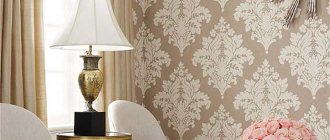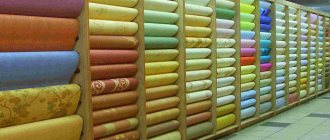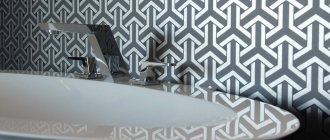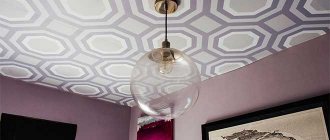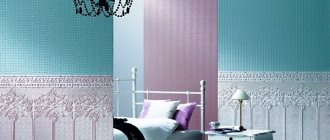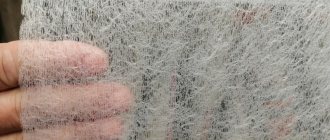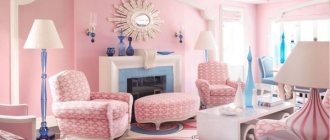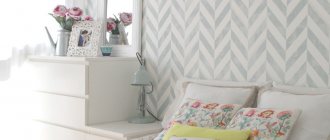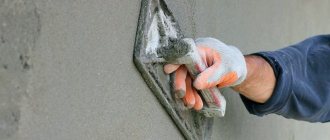Many years ago, during the times of the Soviet Union, construction experts advised using paper or ordinary newspaper sheets as the first layer before gluing trellises. Such a backing for wallpaper improved adhesion to the wall and slightly increased the temperature of the walls, which was especially noticeable in the cold season.
Today, the range of substrates has increased significantly. And their main task was heat and sound insulation. This is especially true in new buildings with thin walls. The second is to hide uneven walls or even stains on them. This way, contaminants will not appear on wall surfaces. It is also important that any type of substrate will protect against the formation of fungus and mold; it consists of two layers of paper, between which there is another material. Let's consider its main types.
Types of paper wallpaper
Paper wallpaper for walls is divided into several categories. These include:
- Simplex model. The product contains one layer of thick paper. Foreign manufacturers have long abandoned this method of manufacturing finishing materials. The photo of paper wallpaper shows this decor model;
- Duplex. This variety is produced in a complex way. For this, 2 types of cellulose are used. They are glued to each other, resulting in a dense paper base. The upper part is decorated with an unusual pattern or texture;
- Structural models. In production, a durable type of cellulose is used, which is pre-impregnated with special compounds. The upper part repels water perfectly. During repair work, there is no need to carefully align the vertical planes. The texture can hide any types of errors. Such wall decor can correct unevenness;
- Photo wallpaper. This type of paper web contains a three-dimensional image on its surface. During production, the photo printing method is used.
Manufacturing from fiber materials
The most expensive commercial mixtures include flax, cotton or silk fibers. You can replace them with regular cotton wool or buy insulation based on wood cellulose, for example, Ecowool. In principle, you can even use scraps of fabric if it is possible to grind them into a small fraction. After all, the smaller the pieces of material, the smoother the material lays on the surface. Synthetic padding polyester, wool or old yarn are suitable.
Fabric fibers can be used to make liquid wallpaper
- Grind all components thoroughly.
- Mix all components with glue. Add a decorative fraction.
- If the mixture is too thick, add a little water to it.
- Testing the liquid mixture. Apply a little to the surface. If the composition applies evenly and generally looks as intended, then you can leave the mixture to mature. At this time, the fibers are evenly saturated with glue. If the composition peels off, you need to add glue; cracks indicate a lack of mineral filler, and if the mixture lags behind the wall, there is an excessive amount of fibers.
While the mixture is maturing, you can start preparing the walls.
Homemade wallpaper has the same properties as factory wallpaper
Advantages of paper wallpaper
Experts highlight a number of positive qualities of these products for decorating interior space. This list includes:
- Availability. Russian-made paper wallpapers have an affordable price. On average, the cost of one roll varies from 100 to 1000 rubles;
- Easy and simple installation. Repairs can be carried out independently without outside help. After applying the glue, the paper strips increase slightly in weight;
- Eco-friendly composition. No chemical additives are used in production. Small amounts of toxic substances may be present in decoration elements;
- Huge selection of color palettes. Models of paper wallpaper for painting are on sale. Now the buyer independently chooses the shade of future walls.
Tools for work
Wallpaper for making blinds, you can take wallpaper from leftovers or buy 1 roll of the color you like.
- scissors;
- hole punch or awl;
- measuring tape or ruler;
- double-sided tape and glue;
- a simple pencil;
- cord, satin ribbon with which the product will be fixed;
- retainer
We recommend choosing thick wallpaper, for example, paintable or duplex paper. They practically do not transmit light and will also last longer. Give preference to ones that are not very variegated and dark. They will not heat up too much and burn out. This means that the wallpaper on the walls can be preserved for a longer period.
Disadvantages of paper wallpaper
In addition to the advantages, there are a number of significant disadvantages that can turn repair work into real torture. They include:
- Low level of strength. After applying the adhesive composition, the paper web loses its endurance and strength. Any sudden movement may cause the scenery to become deformed;
- Not able to withstand high levels of humidity. To decorate the kitchen, they prefer to choose paper wallpaper with water-repellent impregnation. This coating can prevent the absorption of moisture from the air. However, after just a year of operation, microcracks appear on the surface of this layer, which actively absorbs liquid;
- Minimum service life. On average, a design using paper wallpaper can last up to 3 years. After this, the surface gradually begins to lose its decorative qualities.
Regardless of the negative aspects of these products, they still remain popular models for decorating designs.
Duplex
They also consist of paper, but the number of layers is two or more. The front side is made according to the same principle as for single-layer ones. Then the next layer or several are added to add strength. Increased strength makes it possible to produce several types of wallpaper:
- Embossed
- Coarsely fibrous
- Moisture resistant
- For painting
Advantages:
- Environmentally friendly.
- Low price.
- They can mask small unevenness on the walls.
- Smoothes out color transitions on the surface.
- They have a longer service life than single-layer ones.
- Not long service life.
- They shrink after gluing.
- All types are rubbed down except moisture-resistant ones.
- There may be damage during the gluing process.
- The price is significantly higher than single-layer ones.
Rough fiber wallpaper
The peculiarity of this coating is its very pronounced texture. This effect is achieved by using sawdust between the layers. Most coarse fiber paper wallpapers are produced for painting. The wallpaper is absolutely natural and environmentally friendly. Particular attention should be paid to the choice of paint for them.
Moisture-resistant wallpaper
This is a two-layer paper wallpaper. A special varnish is applied to the front side, on top of the design, and a backing is applied underneath. When gluing to walls, special attention should be paid to joining the panels to avoid moisture ingress and peeling.
Two-layer paper wallpaper on which the design is applied using embossing. Structural wallpaper is more suitable for painting.
Non-woven base
This type of coating was created for those who put their health first; they are absolutely environmentally friendly. Plus, this type of wallpaper has several advantages compared to ordinary paper wallpaper. The non-woven base makes it possible to glue them to unprepared walls, as it masks some unevenness.
It is enough to apply the glue only to the wall. The canvases do not shrink and are glued end to end. Among the disadvantages, the price is significantly higher and all the disadvantages of a paper surface.
Paper based textiles
This type is made both on a paper basis and on non-woven fabric. The front part is covered with fabric. These wallpapers are of a fairly high price category. The price depends only on the material of the front side.
Paper backed vinyl
This is the most popular type of wallpaper. Excellent combination of price and quality.
Photo wallpaper
This is the cheapest wall covering. It is produced not in rolls, but in several parts. The top is sometimes varnished. The backing can be not only paper, but also vinyl or non-woven.
They consist of foamed acrylic applied to a paper backing. It is thanks to this application that this type of wallpaper retains its ability to allow air to pass through.
Criteria for correct selection
Experts recommend taking into account several important factors when choosing cellulose wallpaper. They include:
- Color palette. For example, paper wallpaper for the bedroom should be made in pastel colors. These shades promote a feeling of comfort and coziness. Colors that are too bright are suitable for rooms that receive sunlight most of the time. For the living room and nursery, you can use rich colors. However, when choosing, it is necessary to take into account the color balance of the entire design of the living area;
- Drawing and pattern. One of the important factors for the perception of the interior is the presence of additional decor. Plain paper canvases allow you to visually increase the area of space. They are recommended to be chosen for small spaces. Large decorations can reduce free space;
- Texture. The paper base can be designed like corrugated paper, with embossed elements, or have a perfectly flat surface;
- Performance characteristics. Depending on the composition, the paper decor should be dense to the touch, able to withstand mechanical stress and have a water-repellent layer;
- Location. They can be glued to the wall and even used to decorate the ceiling;
- Texture for further deformation. In this case, you can decorate the wall decor yourself with water-based compositions. Painting wallpaper helps create a unified interior. It is carried out after the vertical surfaces have completely dried.
Calculation of paper and water
It is very important to maintain the proportion when mixing components; if everything is clear with factory-made wallpaper, then when making it yourself, the proportion can only be determined experimentally. For example, forty sheets of A4 paper will require 1.25 liters of water. Dividing the amount of water into the sheets, we get 30 ml of water per sheet. Thus, any cellulose material can be calculated. To calculate, you will need scales and shredded paper.
All ingredients must be mixed thoroughly
We calculate:
- paper density 80 g/m2;
- the area of the A4 sheet is 0.06 m2;
- We calculate the weight of the sheet by multiplying the area by the paper density, we get 5 g;
- to understand how much water is per gram of paper, divide 30 ml by the weight of the sheet, for a total of 6 ml.
For 40 sheets of paper you will need 200 ml of glue and 40 five-gram spoons of gypsum or plaster putty.
Advice. To prevent fungus from forming on the wallpaper in the kitchen due to humidity and having to remove the entire coating, prime the walls with an antifungal compound before applying the wallpaper.
Choosing wallpaper glue
What glue is suitable for paper wallpaper? When choosing a working composition, experts recommend taking into account the structure and type of paper decor. The packaging contains the relevant information, composition and correct ratio of components when preparing the mixture.
Many designers recommend choosing a universal composition that is suitable for almost any type of cellulose coating. Most of the composition is occupied by various cellulose derivatives, which are mixed with antiseptics and fungicides.
Adhesive components play an important role. Particles of polyvinyl chloride, when interacting with water and cellulose derivatives, form a dense substance, which, when interacting with a concrete plane, provides additional strength.
Cellulose wallpaper is considered the lightest among this category of decor. After applying the adhesive base, they are immediately glued to the concrete plane. The room dries after pasting within 3 hours.
How to prepare glue?
To properly prepare the adhesive solution, it is necessary to maintain the proportions of water and active substance. First, pour the required volume of warm liquid into the container. Next, add dry ingredients and mix quickly.
Note!
Glass wallpaper - what is it? Pros and cons, types, features, characteristics, photos of design and combinations in the interior
Plain wallpaper - 150 photos of modern design. Rules for choosing and combining wallpaper in the interior: kitchen, bedroom, living room, hallway
Wallpaper framed on the wall in the interior: photos of original design and beautiful decor
After this, leave the container with the working composition for 30 minutes to completely dissolve all particles. During this time, the cellulose particles will gain volume and the adhesive composition will become thick.
Wallpaper gluing technology
How to glue paper wallpaper? During the repair process, it is recommended to adhere to several actions:
- First, the surfaces of the walls are cleaned of remnants of old decor. For work, use a construction spatula and a spray gun;
- If the concrete surface was painted with oil-based enamel or water-based paint, then in order to firmly fix the new wallpaper it is necessary to completely remove the remnants of the dense shell;
- Using putty we remove traces of external deformations in the form of cracks and chips. The dense composition fills well all the imperfections on the wall;
- Next, we prime the plane. For work use a soft roller or brush. We treat the walls in three layers and leave them to dry for 3 hours;
- Now let's start preparing paper blanks. To do this, we use a construction meter, thanks to which we can calculate the height from the ceiling to the floor. Next, you can move on to the process of cutting paper strips. We cut the roll into several identical parts with an additional allowance of 1 cm. If the walls in the room are crooked and have many flaws, then to disguise them you will need allowances ranging in size from 5 to 15 cm. Thus, the fitting method allows you to hide errors and make the interior cozy . If the model does not contain a drawing or pattern, then the absence of these elements increases the speed of the work process. If there are additional decorations, it is recommended to correctly combine all lines and protrusions;
- Let's move on to marking the wall. Professionals recommend starting gluing from the window opening. Using a building level, we measure the width and length for each strip. Using a simple pencil, draw a marking that will act as a guide line;
- Now carefully lubricate each side with adhesive solution. Using a wide brush or soft roller, evenly cover the back side. After this, the edges are shifted to the middle and left for deeper absorption of the adhesive liquid. Experts recommend taking into account that after applying the working composition, the length of the cellulose decor increases by one and a half times;
- Next, apply it to the plane and carefully smooth the surface using a silicone spatula or soft cloth. We start the movement from the middle to the edges. Such manipulations allow you to remove up to 40% of excess liquid. It is recommended to stick the strips strictly in a vertical position. To work, you can use a plumb line or adhere to the drawn mark. To avoid visible joints, it is recommended to use a rubber roller. In the baseboard area you will need to use a utility knife. He recommends finishing the pasting process above the doorway. Here it is important to carefully measure the distance and avoid the appearance of a volumetric allowance;
- When the entire room is wallpapered, leave the space until completely dry. This may take from 3 to 5 hours depending on the size of the room. After this time, the room can be ventilated and cleaned.
